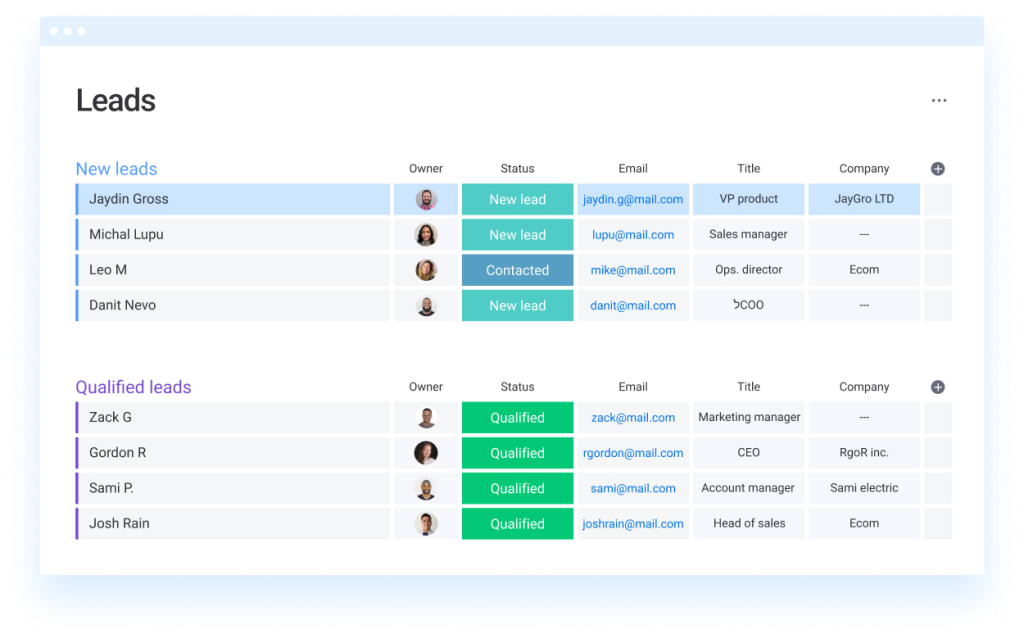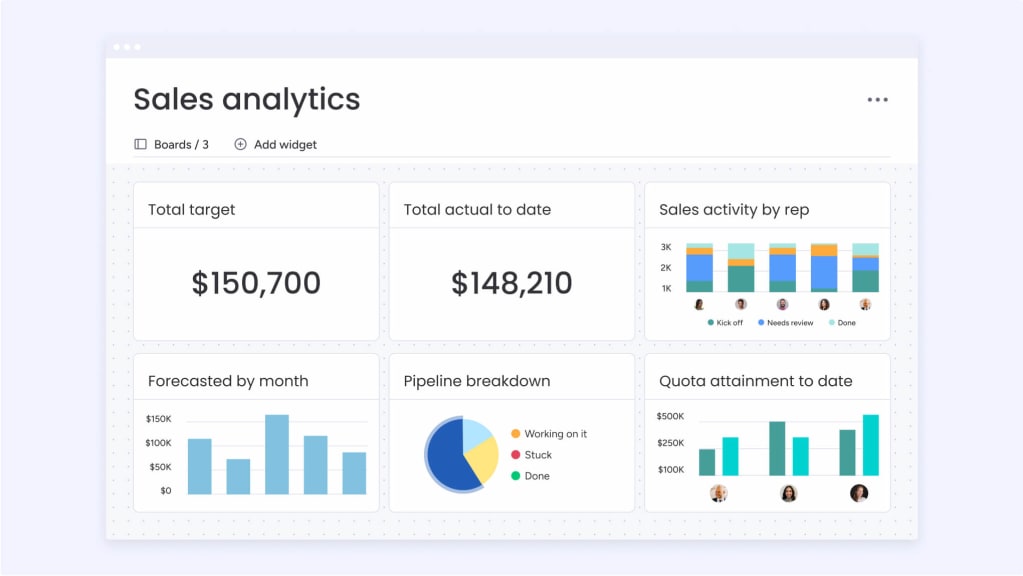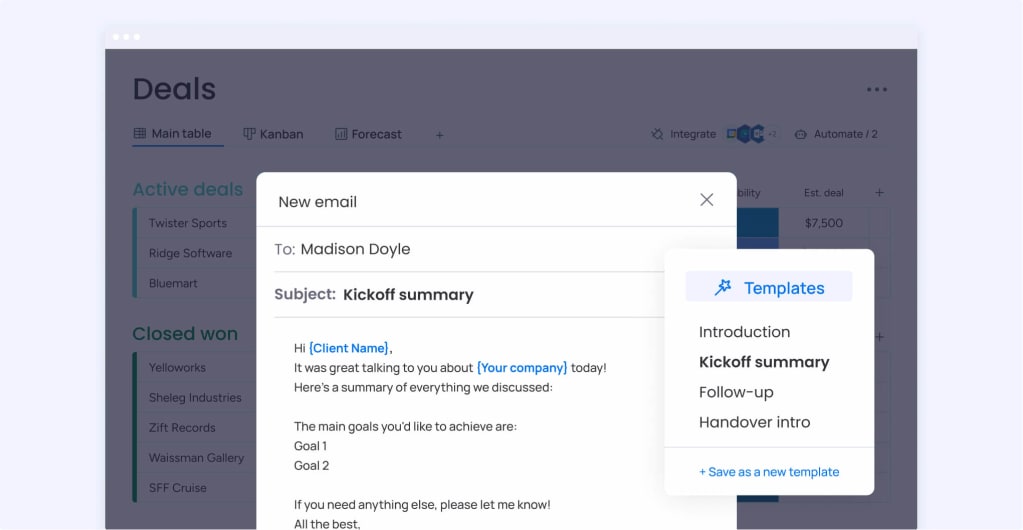The moment your content, product, or service catches someone’s attention, you have a lead. Whether that lead actually becomes a customer—and how quickly they do— largely comes down to the quality of your lead management process.
But what exactly does that process look like, and how can you make it work for your business?
Here, we’ll take you through the stages of lead management, how to measure their impact, and how monday sales CRM can help you streamline the process and convert more leads into satisfied customers.
Try monday sales CRMWhat is lead management?

Lead management is the process of guiding your leads from that first spark of interest in your product or your service, all the way to becoming a happy customer.
Here’s an example of the end-to-end journey of lead management:
Let’s say that you run an ad on Facebook. Someone likes the look of your ad and clicks on it. They arrive on your ad landing page. There, you’ve got an offer for a report they might like to read. To get the report, they need to fill in a form to give you their email address. At that point, that person has become a lead. Now, it’s your job to nurture that relationship and keep them interested. Maybe you’ll send them a series of emails. In the final email, you might suggest they have a call with a member of your team to see if your product could be useful to them. If they say yes to a call, they’ve become a warm lead. If the call goes well, they might tell you they’re ready to buy (we’d call them a hot lead at that point). All you’ve got to do now is help make sure that they actually get out their credit card!
That’s lead management—helping potential customers go through the journey from “not interested” to “interested” to “very interested” and finally to “paying customer.”
What is the lead management process?
The process of lead management includes:
- Finding new prospective customers
- Determining if they are a good fit
- Building a rapport through great communication
- Encouraging them to buy your product or service
Managing that process well is what helps you convert a good percentage of new leads into customers.
Why is lead management important to scale your business?
Businesses with a mature lead strategy generate 133% more revenue than average. That’s because potential customers are more likely to trust and buy from a company that puts the time and effort into addressing their needs and pain points — rather than a company that’s clearly focusing solely on their own sales figures.
A great lead management strategy helps you to scale your business by:
- Removing bottlenecks in your sales funnel
- Helping you to prioritize your leads, so you don’t waste time and resources on leads that won’t ever buy from you
- Building stronger relationships with those leads with most potential of becoming customers
- Using automation to speed up your processes and make your operations more efficient
What are the 6 stages of a lead management process?
If you want to increase and strengthen your customer base, you need to engage with your leads throughout your sales funnel. Here are the six steps that make up a comprehensive lead management process:
1. Lead capture
Generating new leads is no good if you don’t have a way to gather their information and start to engage with them. Lead capture is the process of using landing pages, short forms, and pop-ups to gather contact details and useful information about your leads – all so you can effectively reach out to them and keep them interested in what you’re offering.
2. Lead tracking
Having identified your leads, you need to follow them throughout their engagement with your company. This stage is known as lead tracking — monitoring and analyzing the details of a lead’s journey through your sales funnel.
Tracking your leads helps you figure out:
- Which sources generate the best leads
- How long it takes for a lead to become a paying customer
- The drop-off rates
- The stages at which leads drop off
This knowledge is crucial for keeping your lead management effective and efficient. A lead-tracking app can be incredibly helpful here. For instance, monday sales CRM lets teams view lead information and interactions at a glance, and clearly understand where each lead stands in the pipeline.
Try monday sales CRM3. Lead qualification
How do you know how likely it is that a lead will become a customer? Lead qualification helps you assess your leads and predict how much you should invest in trying to convert them. Lead qualification involves:
- Defining an ideal customer profile (ICP) – creating a clear description of the kind of person who buys your products
- Using lead qualifying questions – asking questions that let you assess the lead’s likelihood of becoming a paying customer
- Calculating the value of each lead with lead scoring – assigning a numerical score to how high-potential your lead is
- Segmenting your leads – sorting your leads into categories, depending on their lead score and where they are in the customer journey, so you can nurture them appropriately
Lead qualification lets you understand your leads and their needs, build stronger relationships, and focus your lead management process effectively.
4. Lead nurturing
Building trust and a positive, lasting relationship with your leads is what will help them progress through the sales funnel, and encourage them to become a paying customer. You’ll need different types of content and messaging for leads at different stages of your sales funnel. Educating top-of-funnel leads and engaging middle-of-funnel leads is just as important as the big ask at the bottom of the funnel.
Customizable email templates can be useful here. With monday sales CRM, you can pair templated emails with automated rules and notifications, so that you know as soon as a lead receives, opens, or replies to an email, and can follow up automatically with a personalized email based on one of our handy templates.
5. Lead distribution and conversion
Making sure you have the right people engaging with each lead is key to converting leads into paying customers. Lead distribution is all about connecting each lead with the best sales rep for them. You need to take into account the experience and expertise of your salespeople so that you can have the best opportunity of closing each sale.
Next in the journey is lead conversion. This is the term for that crucial moment when you turn a lead into a paying customer. The formula for calculating your lead conversion rate is:
LCR = (Total number of conversions / Total number of leads) x 100
So, if you captured and nurtured 100 leads, and 10 of those leads subsequently bought your product or service, your lead conversion rate would be 10%.
6. Leads analytics and reporting

Understanding your leads’ behavior is important for optimizing your top-of-funnel marketing, speeding up your response rates, and ultimately increasing your conversions. Lead analytics and reporting allows you to:
- Understand your leads and customers
- Identify trends and patterns
- Personalize your interactions to address their priorities and pain points
With monday sales CRM, you can use funnel charts and leaderboards to get a clear perspective of your conversion rates and understand how well your Sales team is doing.
Try monday sales CRMThe lead management process is not necessarily a linear, step-by-step journey. While lead capturing happens at the top of the funnel and lead conversion at the bottom, you should be tracking and nurturing your leads all along the way.
What benefits does an effective lead management process offer?
An effective lead management process helps you:
- Deliver real return on investment from your marketing spend
- Reduce inefficiencies and build opportunities in your sales pipeline
- Segment your leads for better personalization
- Prioritize and follow up more quickly with your most promising leads
What are the different types of leads?
It’s essential to approach your leads appropriately, depending on whether they are cold, warm, or hot leads.
Cold Leads
Cold leads are the sales leads that sit right at the top of your sales funnel. That means they’ve never interacted with your company, or shown an interest in your product or service before.
Clearly, they’re the toughest nut to crack—but by doing your research, offering clear value and personalizing your approach, cold leads can warm up to your company. That said, it’s also important to know when to let go of cold leads if they are not productive, so that you don’t expend more resources than you need to.
Warm Leads
Warm leads are a more enticing prospect. These are people who are already familiar with your brand, and have shown an active interest in your product or service. They’ll typically have already provided their contact details, for example by:
- Signing up for your newsletter
- Accessing a lead magnet such as an ebook
- Engaging with your live chatbot
- Being referred by one of your existing leads or customers.
Either way, qualifying warm leads is easier since they’re already open to dealing with you.
Hot Leads
Hot leads are generally the easiest type to win over, because they’re already at the bottom of your sales funnel. They’ve looked at your product or service from all sides, had a demo, and decided it’s what they need. They’ve got the budget and the authority to buy, and they’re ready to close the deal.
What are raw leads and how are they different from qualified leads?
When leads enter your sales funnel, they are raw leads. When you analyze them, evaluate their potential for becoming paying customers, and determine the next steps for engagement, they become qualified leads.
Qualified leads can be divided into two categories:
1. Marketing Qualified Leads (MQL): Marketing qualified leads are interested prospects that are not yet ready to buy and still need some nurturing by your Marketing team.
2. Sales Qualified Leads (SQL): Sales qualified leads are prospective customers ready to deal with your Sales team.
Lead management is all about making the most of the opportunities your leads present. This is why it’s so important to qualify your leads as soon as they come your way.
What are the metrics to track for lead management?
A good lead management process relies on having clear and comprehensive insights into how effectively it is working. A powerful customer relationship management (CRM) tool like monday sales CRM can help to track meaningful marketing metrics, intelligently segment your leads, and support lead nurturing.
Try monday sales CRMYou should use your CRM to track key metrics about your leads, including:
- Lead conversion rates: how effective you are at turning leads into prospective customers
- Time to convert: how long it takes for a lead to become a prospect
- Lead score: how likely each lead is to become a customer
- Lead sources: where your leads are coming from
- Lead progress: where each lead is in your sales pipeline
- Customer lifetime value: how much each customer is worth
Your lead management process made simple with monday sales CRM
Empower your marketing and sales teams to efficiently manage the entire sales cycle with a single, intuitive, customizable, no-code platform.
monday sales CRM makes lead management easy, with:

- Email templates and automated follow-ups to effortlessly nurture your leads and encourage them to move through the sales funnel
- An easy-to-use, centralized platform to keep every lead in one place, whether they came in through your website, via Facebook campaigns, or from other sources
- Visual dashboards to see exactly where your leads are in the pipeline, handle lead distribution and make sure you never drop the ball
- Sales analytics tools that let you make data-driven decisions with real-time tracking and reporting
From lead capturing through nurturing, all the way to closing the sale, monday sales CRM lets you analyze and track your lead management process every step of the way. Give it a try for free today and instantly streamline your lead generation and management, personalize your approach to suit your audience, and leverage customizable features and collaboration tools to drive your business forward.

